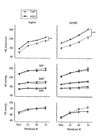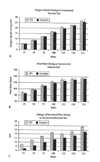POTS versus deconditioning: the same or different?
- PMID: 18704621
- PMCID: PMC3770293
- DOI: 10.1007/s10286-008-0487-7
POTS versus deconditioning: the same or different?
Abstract
The 2007 Streeten Lecture focused on the idea that physical deconditioning plays a key role in the symptomology and pathophysiology of POTS. Parallels were drawn between the physiological responses to orthostatic stress seen in POTS patients and the physiological responses seen in "normal" humans after prolonged periods of bedrest, deconditioning, or space flight. Additionally, the idea that endurance exercise training might ameliorate some of these symptoms was also advanced. Finally, potential parallels between POTS, chronic fatigue syndrome, and fibromyalgia were also drawn and the potential role of exercise training as a "therapeutic intervention" in all three conditions was raised. The conceptual model for the lecture was that after some "initiating event" chronic deconditioning plays a significant role in the pathophysiology of these conditions, and these physiological changes in conjunction with "somatic hypervigilence" explain many of the complaints that this diverse group of patients have. Additionally, the idea that systematic endurance exercise training might be helpful was advanced, and data supportive of this idea was reviewed. The main conclusion is that the medical community must retain their empathy for patients with unusual conditions but at the same time send a firm but empowering message about physical activity. As always, we must also ask what do the ideas about physical activity and inactivity and the conditions mentioned above not explain?
Figures







Comment in
-
All that shine is not gold: modelling the true relation between orthostatic intolerance, fibromyalgia and chronic fatigue syndromes.Clin Auton Res. 2008 Dec;18(6):298; author reply 299. doi: 10.1007/s10286-008-0498-4. Clin Auton Res. 2008. PMID: 18932009 No abstract available.
References
-
- Benrud-Larson LM, Dewar MS, Sandroni P, Rummans TA, Haythornthwaite JA, Low PA. Quality of life in patients with postural tachycardia syndrome. Mayo Clin Proc. 2002;77:531–537. - PubMed
-
- Benrud-Larson LM, Sandroni P, Haythornthwaite JA, Rummans TA, Low PA. Correlates of functional disability in patients with postural tachycardia syndrome: preliminary cross-sectional findings. Health Psychol. 2003;22:643–648. - PubMed
-
- Bonyhay I, Freeman R. Sympathetic nerve activity in response to hypotensive stress in the postural tachycardia syndrome. Circulation. 2004;110:3193–3198. - PubMed
-
- Dorfman TA, Levine BD, Tillery T, Peshock RM, Hastings JL, Schneider SM, Macias BR, Biolo G, Hargens AR. Cardiac atrophy in women following bed rest. J Appl Physiol. 2007;103:8–16. - PubMed
Publication types
MeSH terms
Grants and funding
LinkOut - more resources
Full Text Sources
Research Materials

